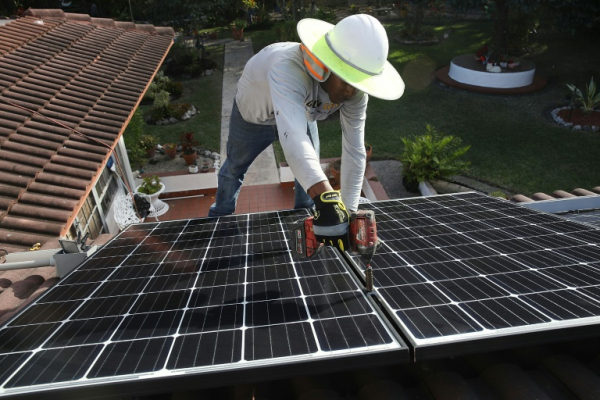Wind, solar could meet 80 percent of US demand: study

Solar energy, such as through these panels being installed on the roof of a Florida house, currently account for one percent of US electricity © JOE RAEDLE – GETTY IMAGES NORTH AMERICA/AFP/File
Wind and solar power could meet 80 percent of US demand for electricity, as long as improvements are made in transmission and storage, researchers said Tuesday.
Until a few years ago, these renewable energy sources were thought to be capable of supplying only about 20-30 percent of US needs, according to the report in the journal Energy and Environmental Science.
Currently, the United States gets about two thirds of its electricity from fossil fuels — natural gas, coal and oil — which contribute to global warming by emitting greenhouse gases that heat the atmosphere.
One-fifth of US electricity comes from nuclear, and another 15 percent is generated from renewables, with wind contributing seven percent, solar just one percent, while hydropower and other sources account for the balance of the clean energy sources, according to the US Energy Information Administration.
To see how much wind and solar could contribute in the years ahead, researchers at the University of California, Irvine; the California Institute of Technology and the Carnegie Institution for Science looked back at 36 years of hourly US weather data — spanning 1980 to 2015.
“We looked at the variability of solar and wind energy over both time and space and compared that to US electricity demand,” said co-author Steven Davis, UCI associate professor of earth system science.
“What we found is that we could reliably get around 80 percent of our electricity from these sources by building either a continental-scale transmission network or facilities that could store 12 hours’ worth of the nation’s electricity demand.”
Expanding US transmission and storage would require a “very substantial — but not inconceivable” investment, the researchers said.
For instance, the new transmission lines required could cost hundreds of billions of dollars.
But storing that much electricity with today’s cheapest batteries would likely cost more than a trillion dollars, the report said.
In the future, the United States — which is the world’s second largest polluter after China — should consider lower-carbon sources of energy to fill the gaps left by solar and wind, said the report.
“Our work indicates that low-carbon-emission power sources will be needed to complement what we can harvest from the wind and sun until storage and transmission capabilities are up to the job,” said co-author Ken Caldeira of the Carnegie Institution for Science.
“Options could include nuclear and hydroelectric power generation, as well as managing demand.” MKH
RELATED STORIES:
PH 5th worldwide, top in Asia in solar power